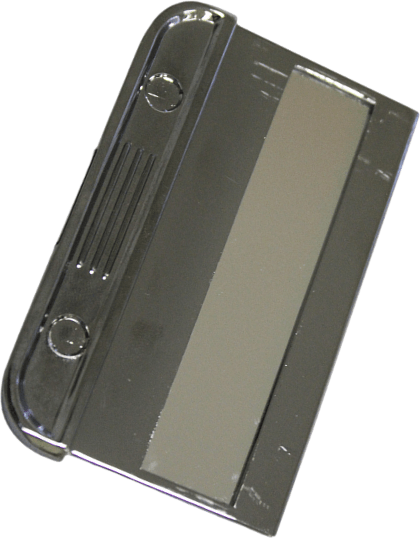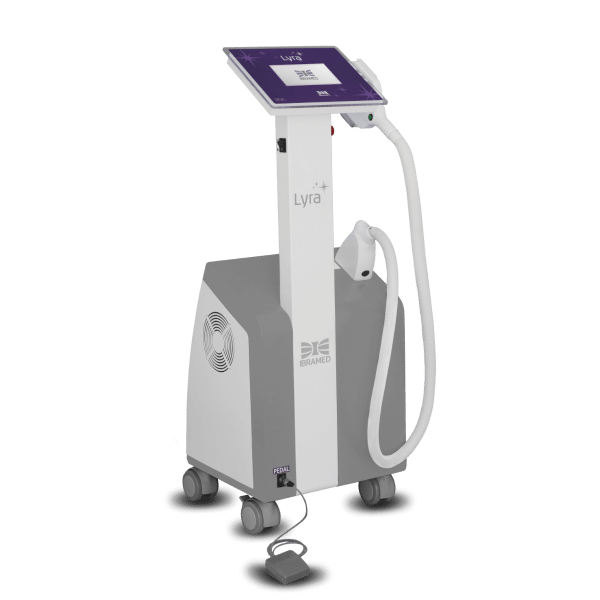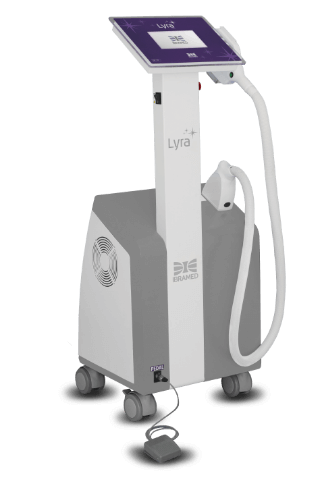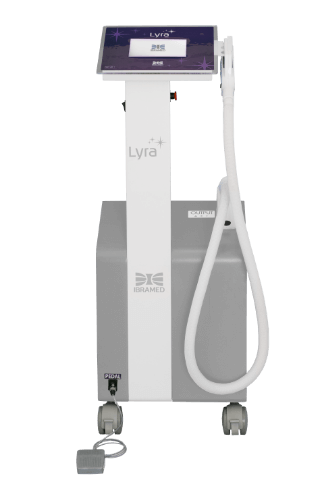Lyra
Intense Pulsed Light with Cryoprotection
The LYRA is a microcontrolled Intense Pulsed Light (IPL) equipment developed for use in aesthetic medicine and aesthetic areas, featuring three selective cut filters with wavelengths of 480 nm, 530 nm and 640 nm, which allow the professional to choose the most suitable spectrum of light radiation for each case and each treatment.
Cryoprotection for increased application security
LYRA has an effective water and peltier cooling system that cools the handpiece tip, called cryoprotection, making the treatment safer and more comfortable, even using high doses of energy. Robust water reservoir and peltier system promote safe, maintained cooling during application.
Actual emission of energy programmed on the display
Lyra was developed to reliably meet the therapeutic goals and allows the real visualization of the energy emitted by the applicator on the equipment display. In this way, Ibramed guarantees safety and effectiveness in treatments.

Selective Cut Filters
Filter 640 nm (red):
Target chromophore -> melanin;
Main indication: hair removal;

Selective Cut Filters
Filter 530 nm (green):
Target chromophore -> hemoglobin;
Main indication: Telangiectasias;

Selective Cut Filters
Filter 480 nm (amber):
Target chromophore -> water, oxyhemoglobin and melanin;
Main indication: rejuvenation and blemishes;
Handpiece shot counter
Lyra features a faithful counter of total shots on the applicator itself, which makes it easier to keep track of the number of shots already taken with the applicator.
Safe and effective pre-programmed protocols
Lyra presents a scientifically based protocol for safe and effective results with adjustment of phototype and hair thickness, which makes the protocol suggested by Ibramed, also personalized for the patient.
Mecanismo de ação e efeitos fisiológicos da luz intensa pulsada
Intense pulsed light is a resource that is based on the use of light for therapeutic purposes and is classified as high power, in which, when interacting with the tissue, it generates a phenomenon called selective photothermolysis (photo: light, thermo : heat; lysis: breakage; therefore, it breaks some target structure by the heat generated by the light; selective because it reaches a target structure, the chromophore, and the adjacent tissues remain intact), similar to what happens with high power laser, but they are different technologies that are similar in that they are based on light and generate heat.
For selective photothermolysis to occur in the tissue, it is necessary to have chromophores or photoreceptors, which absorb light energy, with specific wavelengths (colors), which is converted into heat and destroys, necroses the specific target. This generates a subclinical inflammatory process in the tissue and reabsorption of cell debris destroyed during the photothermolysis process occurs. The main chromophores in our tissues when it comes to IPL are melanin and hemoglobin.
Intense pulsed light emits different wavelengths (colors), between 400 nm and 1200 nm, that is, all the colors of the visible spectrum (violet, blue, green, yellow, amber, red) and near infrared, so we see a white light during its emission. In addition, its light beams, unlike the laser, are incoherent and non-collimated, that is, they spread out in the middle, which is why we see a flash. Unlike the laser which has only one color (monochromatic) and is collimated, coherent and unidirectional.
Because it has different wavelengths, IPL reaches different chromophores at the same time, a characteristic that makes it suitable for various treatments such as acne, telangiectasias, hyperchromias, photorejuvenation, photoepilation. The number of sessions depends on the objective, phototype and individual response.
Device information
- 1 PP Female IEC cable – 3 × 0.7 5 x 1500mm (Code 03017007);
- 1 applicator of 7.5cm² (Code 02037920);
- 1 filter for 640nm (Code 03026102);
- 1 filter for 530nm (Cod. 03026101);
- 1 filter for 480nm (Code 03026100);
- 1 operator safety goggles (Code 03038188);
- 1 protective eyewear for the patient (Code 03026104);
- 1 trigger pedal (Code 02039229);
- 1 digital operations manual (Code 03040015);
- 6 8mm plugs for push-in (Code 03015118);
- 1 10A 20AG fuse (Code 02039617);
- 1 funnel and drain for filling the reservoir (Code 02039717);
- 1 small crystal pink plastic bag (Code 03026112);
- 1 tube of 1 kg with colorless gel – ANVISA registration nº 80122200001 (Code 03044016);
- 1 spatula for gel (Code 03026096);
- 1 200ml cuvette (Code 03026095).
Lyra is a device microcontrolled by intense pulsed light for use in aesthetic treatments. It allows switching of 3 selective cut filters with wavelengths of 480nm, 530nm and 640nm, which allow the choice of the proper spectrum of light radiation for each treatment.
Lyra also has: a tip with a 7.5cm² spot, ensuring greater versatility in treatments; a cryoprotection system (water and peltier), which makes the treatment safer and more comfortable; lamp with a lifetime of 1 million shots, which allows for better linear and functional performance; modern design with touchscreen control; informative tutorial and protocols.
The equipment should only be used under the prescription and supervision of a licensed professional.
Cutting Filters
With the help of filters, it is possible to select wavelengths according to the depth of the structure to be reached. The LIP emission spectrum varies from 450 to 1200nm and, for example: when using the 640nm filter, emission only occurs in the spectrum from 640 to 1200nm, blocking the emission of the shorter lengths.
Lyra offers a handpiece with the possibility of switching 3 selective cut filters, with wavelengths of 480nm, 530nm and 640nm, which allow the choice of the most suitable spectrum of light radiation for each treatment. The indications are:
Hair Removal: the filter ranges from 640nm or 690nm to 1200nm;
Telangiectasias: the filter varies from 530nm to 1200nm;
Rejuvenation: the filter ranges from 480nm to 1200nm;
Skin blemishes: the filter ranges from 480nm to 1200nm.
The basic principle is the absorption of photons by endogenous or exogenous chromophores within the skin and the transfer of energy to these chromophores. This transfer generates heat which subsequently destroys the target structure.
The absorption of light is not linked to the coherence of light, the so-called photobiological reaction occurs regardless of the heating source. Furthermore, human skin chromophores (hemoglobin, melanin and water) show broad absorption spectra, thus monochromaticity is not a requirement for photothermolysis. As LIP devices emit a spectrum of wavelengths, all three chromophores can be activated with a single exposure to light. This versatility implies a reduction in selectivity. On the other hand, the type and condition of the patient’s skin determine the choice of appropriate cut-off filters and, consequently, the spectrum of wavelengths to be emitted.
Precautions
- Avoid sun exposure of the treated areas for at least 5 days after application;
- We strongly recommend the daily use of an FP60 sunscreen and a medical evaluation prior to performing IPL treatments in cases where the patient has any skin pathology;
- Do not submit to IPL therapy the patient who is being treated with antibiotics, is ingesting vitamin A and/or K supplements, or another melanin-stimulating substance;
- In hair removal treatments, the use of other hair removal practices should be avoided in the two weeks before and two weeks after the application of IPL. Just shave the hair;
- High phototype skins (dark or very tanned) require greater attention when prescribing the dosage for the application of IPL;
- Immediately after application, a slight erythema and/or transient swelling may occur, which disappears within 3 hours after application. The use of soothing lotions and/or cold compresses on the treated areas can minimize this effect;
- Rarely, more intense erythema may appear and disappear between 2 and 7 days after application, without the need for additional treatments. However, if desired, the use of products such as: tranquilizers, gels, creams or specific ointments can accelerate the recovery process;
- All treated areas should be cleaned with mild soap and water.
Adverse Reactions
There are no significant records of more serious adverse reactions (transient or permanent) resulting from the use of IPL therapy, as long as the application dosages are suitable for the patient. However, there may be:
- Transient hyperpigmentation (resolved without adjuvant treatments within a maximum of 6 months after application);
- Dischromias;
- Itching;
- Burns;
- Local erythema or edema (from 30 minutes to 72 hours);
- Purple.
Preventions
- Transient hyperpigmentation (resolved without adjuvant treatments within a maximum of 6 months after application);
- Dischromias;
- Itching;
- Burns;
- Local erythema or edema (from 30 minutes to 72 hours);
- Purple.
- Hair removal;
- Permanent hair reduction;
- Rosacea;
- Treatment of acneic skin;
- Telangiectasias;
- Benign pigmented lesions;
- Skin photoaging (rejuvenation).
- Pregnant women or intending to become pregnant;
- Patients who are undergoing natural or artificial tanning processes up to 4 weeks prior to treatment;
- In areas with suspicious spots or that contain potentially cancerous tissue;
- Treatment site with tattoo or permanent makeup;
- Aim directly at the eyes;
- Directed application or over the eyes;
- Implanted electronic device (eg, cardiac pacemaker, deep brain stimulation device, etc.);
- Patient with photosensitive epilepsy;
- Concurrent use of photosensitizing drugs;
- Patients who have particular sensitivity to sunlight or photosensitivity-related illnesses (example: porphyria, polymorphic light rash, solar urticaria, lupus or other autoimmune diseases);
- Patients with healing deficit due to Diabetes mellitus or other pathologies.
How to assess the skin phototype for Lyra application?
To assess the patient’s skin type, use the Fitzpatrick classification. Consider whether the patient has a darkened scar in the area of a wound or has a history of keloids.
What interval between sessions and number of sessions for treatments?
Our suggested range and number of sessions is: area, range and number.
What factors can influence IPL treatment?
Tanning, skin temperature, blood perfusion, density of sebaceous glands, presence of hair follicles and skin firmness are factors that can influence treatment with IPL.
How do I fill the water tank?
Remove the two plugs from the supply connectors. Then connect the hoses to the Water Supply and Water Vent.
How to carry out the Lyra application pre-test?
Select a discreet area with skin tone (phototype) similar to the area to be treated, program the equipment and apply 1 or 2 shots at the location. Observe the reaction immediately after 10 to 15 minutes.



